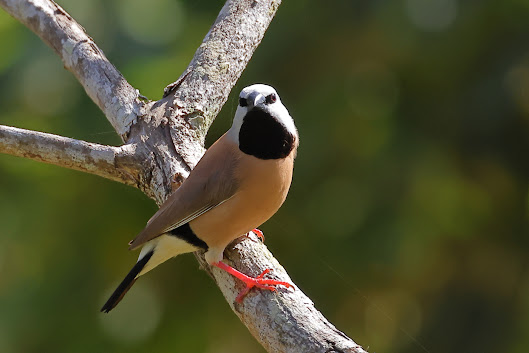


Young Helmeted Friarbird puts the bite on a grasshopper captured by a parent bird in plantings at the Tyto entrance today. Muted begging noises rose sharply when the food was withdrawn. The wait was brief, just long enough for another softening-up chew by the parent before the grasshopper was passed on. Nictitating membrane closure is probably reflex and not blissful savouring of the moment!

A few Golden-headed Cisticolas made their first showings since the floods, but no sign yet of Tawny Grassbirds. Comb-crested Jacanas and White-browed Crakes carry on as normal. The only other birds showing out on and near the water were two trios of Magpie Geese (almost always in threes) and three Wandering Whistling Ducks.
And in the wake of the flood comes the threat of invasion. There's always Hymenachne (H. amplexicaulis) springing up amid the Scleria and reeds. But previous floods have brought the even worse Salvinia (S. molesta) and Water Hyacinth (Eichhornia crassipes) into the system. So the spray boat was launched today to do a sweep of the main lagoon. It's a sign that the town's returning to normal!
I hadn't realised there was a good-news side to Salvinia. Here it is, from a CSIRO site:
In 1978, CSIRO scientists began the search for biological control agents in southeast Brazil which they had identified as the native range of salvinia. They found three promising potential agents: a weevil (Cyrtobagous salviniae), a moth (Samea multiplicalis), a grasshopper (Paulinia acuminata).
C. salviniae was the first to go through the formalities required before an agent can be released in Australia. In 1980, the first releases were made on Lake Moondarra, an artificial lake providing water and recreation for Mt Isa in north Queensland, which was heavily infested with salvinia. By mid-1981, the beetle had reduced the salvinia to a few small patches.
This one, 2 mm long weevil went on to clear massive infestations of salvinia in areas like the Sepik River (Papua New Guinea), Sri Lanka, Wappa Dam and Lake Moondara (Queensland, Australia) and lagoons in the Northern Territory, Australia, including in Kakadu National Park. In all, salvinia has been controlled by C. salviniae in at least 13 tropical countries.
The CSIRO team that unravelled the complex story of salvinia and Cyrtobagous taxonomy and instigated the biological control project received the UNESCO Science Prize in 1985 for their work in PNG.
A win for the good guys! Pity there's no such story with Hymenachne, which was officially released for pond planting as recently as 1988. Did someone say 'slow learners'?




Great close-up shots Tony.
ReplyDeleteCheers
Denis
G'day Tony,
ReplyDeleteNice weevil and weed story. Yeah, I reckon we're slow learners. Hard to stop the intentional introductions though. Good luck to all with the control program.
Gouldiae
A great series of photos! Plus it sent me back to my books to learn that Noisy's take insects too. I'm learning - slowly!
ReplyDeleteThanks Denis.
ReplyDeleteHi Gouldiae: Seems impossible to stop the 'carefully researched, no-risk introductions'. Suggests radical change in vetting is needed. I'm not hopeful.
Hi Mick: Nectar's nice but you can't ignore protein.
Irresponsible aquarium owners have a lot to answer for, the Brazilian Water Milfoil has spread like wildfire in waterways down here.
ReplyDeleteHi Duncan: It amazes me how many people seem determined to send the environment down the drain (or toilet)!
ReplyDelete